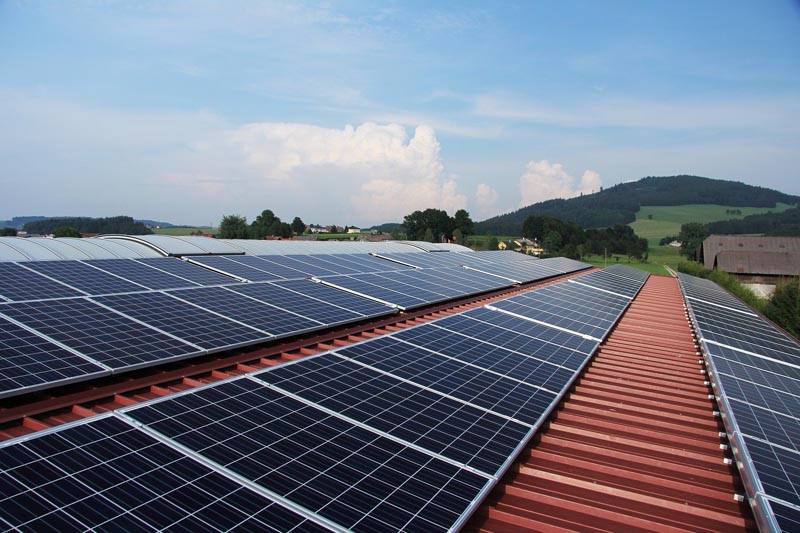
1. Szerkezeti szilárdság és tető illeszkedése
• Válasszon ki egy olyan fotovoltaikus konzolt, amely megfelel a Fotovoltaikus Erőművek Tervezési Szabályzatának (GB50797-2012), ≥ 2,0 mm acéllemez vastagságú és ≥ 60 µm tűzihorganyzott acél vastagságú; ≥ 80 µm tengerparti területeken.
• Végezzen tetőterhelés-számításokat annak biztosítására, hogy a konzol teljes terhelése ≤ tetőterhelési határérték; szükség esetén erősítse meg a tetőszerkezetet, vagy használjon könnyűsúlyú alumíniumötvözet/rozsdamentes acél konzolok.
2. Vízálló, villámvédelem, ekvipotenciális
• Konzol felszerelése a vízálló réteg roncsolása nélkül, ha perforációra van szükség, vízálló burkolatot és megfelelő tömítést kell alkalmazni
• Minden fém alkatrészt megbízhatóan földelni kell az ekvipotenciális kapcsolat kialakítása érdekében, a földelési ellenállást pedig a zivatarszezon előtt ellenőrizni kell, és a korróziógátló réteget újra kell festeni.
3. Kábel korrózióvédelem és kábelezés
• UV-álló és öregedésgátló bevonatot alkalmazzon PV DC kábelekmenetes csövek vagy vízálló hornyok fektetése a tetőre, kerülve a közvetlen külső hatásokat
• A kábel külső köpenyének rendszeres ellenőrzése, a korrózió észlelése és időben történő cseréje
4. Rendszertervezés és árnyékelemzés
• Árnyékolás, dőlés és azimut optimalizálása PV tervezőszoftver (pl. PVSyst) segítségével annak biztosítására, hogy az átlagos éves energiatermelés megfeleljen az elvárásoknak
• A modellek kiválasztásakor vegye figyelembe a helyi napsütést, a szélirányt, a hóterhelést és egyéb éghajlati tényezőket, és ésszerűen határozza meg a konzol dőlésszögét.
5. Szerződések és tulajdonjogok
• A szerződés meghatározza a tető tulajdonjogát, a bérleti szerződés időtartamát, a bérleti díj számlázásának módját, a karbantartásért való felelősséget, a kötbéreket, valamint a tető lebontásának és áthelyezésének kártérítési feltételeit.
• A tetőre szerelt fotovoltaikus rendszer bérleti szerződésének aláírásakor a tető tulajdonosával egyezzenek meg az épület bontásával és a tulajdonjog változásával járó kockázatok megosztásáról.
6. Anyagminőség-ellenőrzés
• Beszerzéskor a beszállítóknak be kell nyújtaniuk a tűzihorgany vastagságának, az acél vastagságának, az anyagminősítési tanúsítványokat; a horganyzott réteg vastagságának és a hegesztési minőségnek a helyszíni mintavételét.
• Nagy szélnyomású területeken vastagabb acéllemezt (≥2,5 mm) vagy kétrétegű konzolszerkezetet kell használni.
7. Építés-, üzemeltetés- és karbantartásmenedzsment
• A kivitelezés előtt fogalmazza meg a „Konzolszerelési Minőségellenőrzési Kézikönyvet”, beleértve a nyitási pontosságra, a csavarrögzítésre, a konzolok szintezésére stb. vonatkozó követelményeket.
• Teljes körű helyszíni átvétel a befejezést követően: a konzol elhelyezését, a földelést, a tömítést, a korrózióvédelmet és a dőléskalibrációt dokumentálni és aláírni kell.
• Hozzon létre rendszeres ellenőrzési programot (félévente egyszer), amely a laza csavarok, a horganyzott réteg leválásának, a konzolok deformációjának, a tető szivárgásának stb. ellenőrzésére összpontosít.